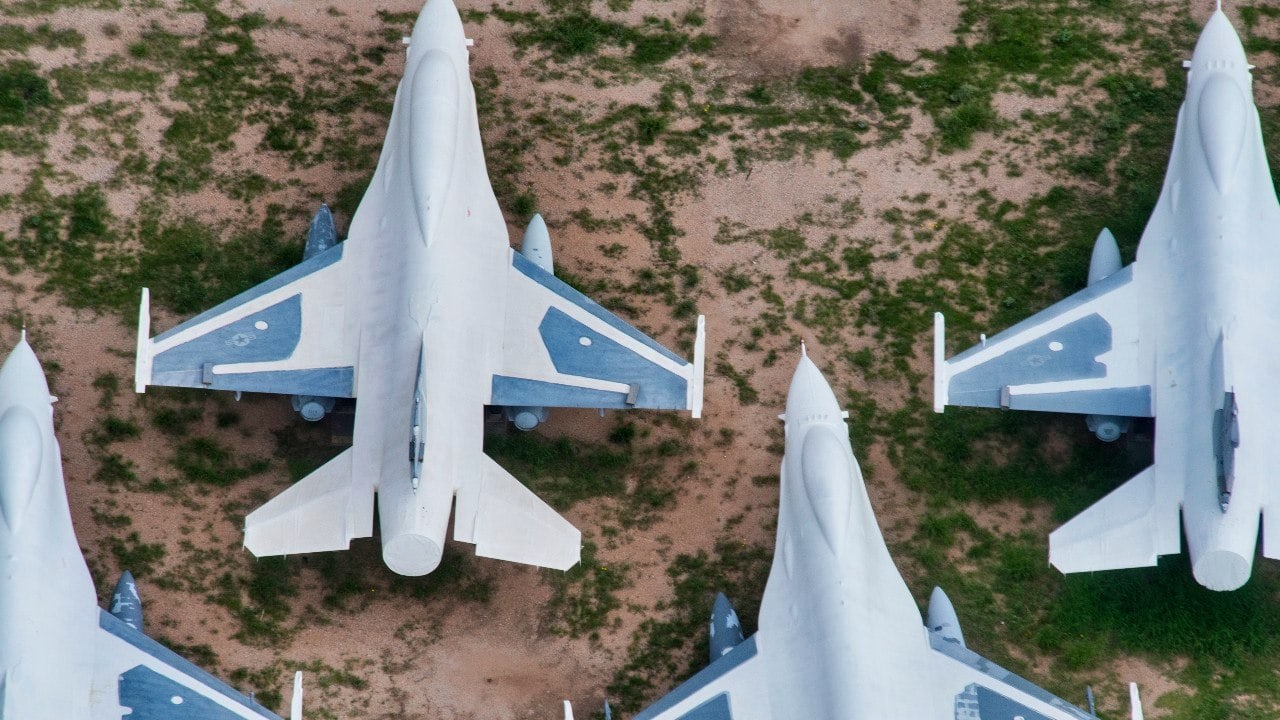It’s hard to believe that the F-16 is 51 years old. And that’s a problem for the Air Force. How do you keep this vital aircraft flying and taking on the bad guys?
The Fighting Falcon just will not grow old. There have been so many upgrades over the years, it is difficult to remember the base model that first came out in the 1970s.
The Air Force is undaunted. The service branch aims to fly the F-16 into the 2040s, which is astonishing given the airplanes that have been retired after far fewer years of service.
The F-16 Block 40 and Block 50 upgrades are progressing, and the Air Force is retiring older warbirds that did not receive those update packages.
The fourth-generation jet is still relevant—indeed, it is fighting a campaign in Ukraine. The United States will rely on the updated Fighting Falcons to police the skies and protect the homeland well into the future.
More Than 600 F-16s Will Be Modernized
An astounding 608 F-16s are slated to receive the upgrades, which are delivered through the Post Block Integration Team. The earliest phase of the effort began in 2022, and the first updated F-16 was delivered in 2023.
Technicians will be working to make 22 improvements to the airplane so it can perform well in contested environments, where it can dogfight or conduct Close Air Support missions to defend troops on the ground.
“Providing this capability on an already time and combat-proven aircraft adds another layer to U.S. Air Force capabilities in an ever-evolving electronic warfare environment,” said General C.Q. Brown, former Chief of Staff of the Air Force. “I know this upgrade will make us even more effective in our day-to-day combat operations, and I look forward to bringing the F-16 even further into the future of air superiority.”
Major Updates Extend the Life of the Fighting Falcon
The modifications are part of the latest Service Life Extension Program. This will extend the F-16’s lifespan from 8,000 flight hours to 12,000 hours.
“The Service Life Extension Program (SLEP) will replace structural bulkheads and longerons, modify wing and wing-box assemblies, install new structural brackets and beam supports and reskin the upper fuselage.
The depot work for the entire process takes up to nine months for each Viper and is being performed at multiple locations both in the United States and in Europe,” according to the Aviationist.
The Radar and Sensor Systems Will Get an Important Boost in Capabilities
The latest SLEP intends to boost the F-16’s survivability and situational awareness so Fighting Falcon pilots can carry out all duties in a safe and effective manner. That requires better radar and sensor systems.
The most important element of the upgrades will be adding the APG-83 Scalable Agile Beam Radar with an Active Electronically Scanned Array radar and a Center Display Unit. This system will help the pilot better recognize and eliminate threats earlier in the observe, orient, decide, and act (OODA) loop.
Say there is a ground target that needs to be destroyed.
The new upgrades allow the F-16 to fly farther away from enemy air defenses and still eliminate enemy personnel and military infrastructure. Thanks to the SLEP, these refurbished fighters can detect and track 20 targets at a time.
Make the Enemy Deaf and Blind
The F-16 also needs a better link between the cockpit controls and the main mission computer. Workers will add the modernized Link 16 system to better connect those elements. Another key update is the improvements to the F-16’s Electronic Warfare suite. This next-generation system will help the F-16 jam and spoof enemy radar and incoming missiles. Better use of chaff and flares is part of these efforts.
The first active-duty F-16A was delivered in January 1979 to the 388th Tactical Fighter Wing at Hill Air Force Base, Utah. The Block 40/42s entered service in 1988. The newer F-16s with the Block 50 designator have been in the fleet since 2005.
How Will the Upgraded F-16s Be Employed?
It is amazing that the F-16 can receive all of these updates. I am still wary of the airplane in modern combat, because it lacks stealth attributes. The F-16 is meant more for ground strike and air policing, in my mind.
It should be considered for use in Day Three and Day Four of a conflict, after stealth fighters and bombers deliver initial shock-and-awe attacks to blind enemy air defenses.
But the quantity and the quality of the F-16 is what gets me excited. The F-16 will also fly with various Air National Guard units around the United States.
This means reserve F-16s can eventually arrive at hot spots while air guard pilots in the backup wings will get much needed experience flying the airplane.
Overall, the F-16 has to be considered a massive success—even more so if it can fly into the 2040s. More F-35s will eventually be built to take their place. However, if the F-16s that receive the modern updates can stay in service another 10 to 15 years, the jet will remain an important platform for the Air Force.
It gives battle planners peace of mind to know that high numbers of modernized F-16s can answer the call if needed in combat.
About the Author: Dr. Brent M. Eastwood
Brent M. Eastwood, PhD is the author of Don’t Turn Your Back On the World: a Conservative Foreign Policy and Humans, Machines, and Data: Future Trends in Warfare plus two other books. Brent was the founder and CEO of a tech firm that predicted world events using artificial intelligence. He served as a legislative fellow for U.S. Senator Tim Scott and advised the senator on defense and foreign policy issues. He has taught at American University, George Washington University, and George Mason University. Brent is a former U.S. Army Infantry officer. He can be followed on X @BMEastwood.

